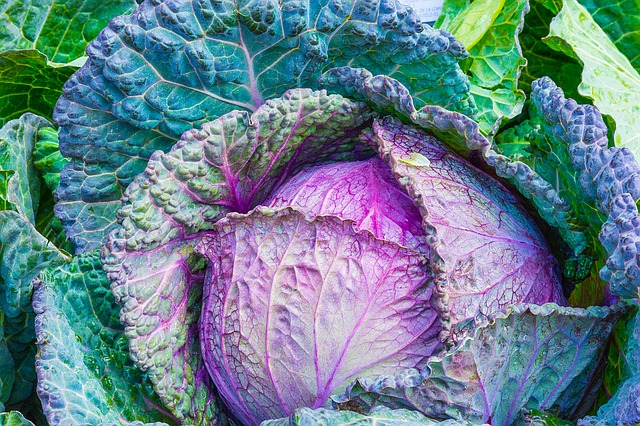Vegan | Low-FODMAP | Gluten-Free | OMS-Friendly
Brassica oleracea
Cabbage is a staple of both the poor and rich and for good reason. It’s meaty, sweet, sulfurous, and can be crunchy or soft, whole or chopped, and it keeps well.
Cabbage goes well in soups and stews, stuffings, salads, and raw, with peppery tones.
Cooked cabbage is savoury and nearly sweet, whereas raw cabbage is peppery and crunchy.
Fermented cabbage
Fermenting allows the bonds in the cabbage to be broken down by bacteria, which then releases different flavours – more sugars, but lactic acid from the bacteria give it a tartness, such as in sauerkraut or kimchi. Salt added brings out the water.
Types of cabbage
Savoy or standard green or red cabbages are the most common.
To keep red cabbage from turning blueish with cooking is to add an acid (vinegar, apples, wine, red wine vinegar). This causes a good, solid red to appear and works with the sweet tones of cabbage.
Green cabbage gets the best flavour from hard-boiling in plenty of water – the longer you cook it, the more sulphur is released.
Ways to enjoy cabbage
- Boiled and pureed, rough or smooth, with olive oil and boiled potato
- Hot cabbage, just tender
- With other ingredients wrapped in a leaf (egg, breadcrumbs, spices, cheeses, rice, tomato sauce)
- Stuffed cabbage
- Raw cabbage salad
Buying and storing cabbage
A regular green or red cabbage should feel tight, hard, and dense, heavy for its size, and no signs of mould or cracking – this cracking can happen after rains. A freshly-harvested cabbage is great all through its edible lifespan from young to more mature, and stores very well. The outside leaves may get a bit worn and old, but the inside stays good for a long time.
Savoy cabbages should look airy, and a bit ruffled, and as if they were still growing. Savoy will start to wilt in a couple of days.
Keep refrigerated and with high humidity, and the ideal storage temperature is actually just at freezing since cabbage freezes one degree below freezing.
Foods that act as complements to cabbage
- Butter, or butter-like olive oil spreads
- Onions
- Garlic
- Chestnuts
- Potato
- Shellfish
- White wine
- Juniper
- Egg
- Fatty meats (pork, duck, tripe, sausage, goose, cured beef and pork)
Wine and cabbage
Cabbage dishes generally aren’t ‘big’ enough to dominate the wine choice of a meal, however, Rieslings generally go well. Dessert wine may not be the best choice.

